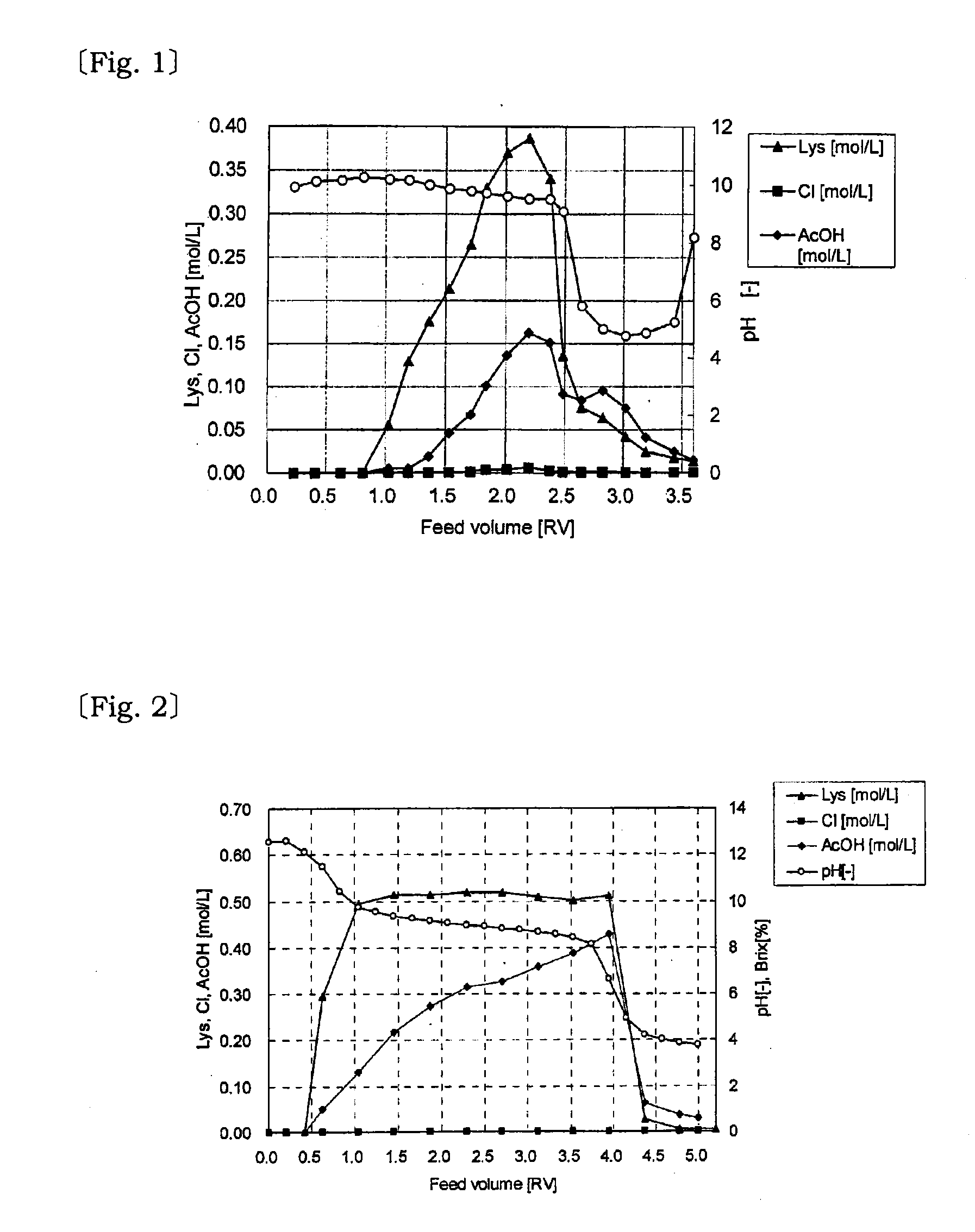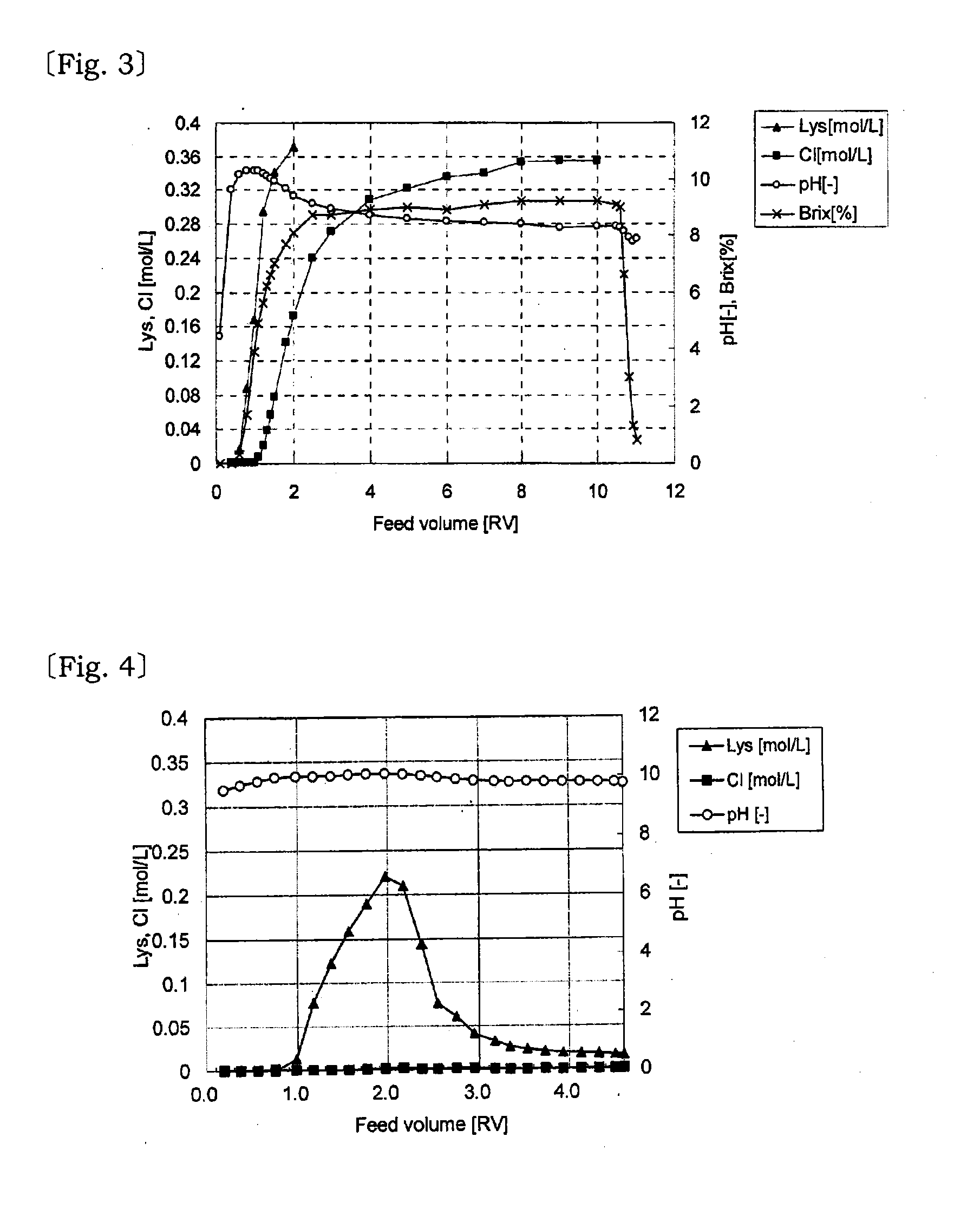Method of producing basic amino acid or basic amino acid salt
- Summary
- Abstract
- Description
- Claims
- Application Information
AI Technical Summary
Benefits of technology
Problems solved by technology
Method used
Image
Examples
example 1
[0046]As the ion-exchange resin, 250 ml of strongly basic amino-exchange resin (Dowex marathon A2, product of Dowex Co., Type II, 1.2 eq / L) was packed in a column, and was regenerated by feeding 3 RV of 1.5 N NaOH, followed by washing with 4 RV of water. The ion-exchange resin was in OH form.
[0047]The feed solution was prepared by dissolving L-lysine HCl salt (for feed) in water, and adding equimolar acetic acid with L-lysine (therefore equivalent mole with HCl). The concentration of L-lysine was 5.0 g / dL.
[0048]1.6 RV of the feed solution was fed at SV=1 from the top of the above column, followed by washing with 2 RV of water.
[0049]The variations of L-lysine concentration (▴), Cl concentration (▪), acetic acid concentration (♦) and pH (◯) of the effluent solution passed through the column and steamed out from the bottom were measured to obtain a graph shown in FIG. 1.
[0050]The obtained results were L-lysine yield of 81%, Cl / L-Lys of the effluent solution=1.5 mol %, and acetic acid y...
example 2
[0051]As the ion-exchange resin, 200 ml of weakly basic anion-exchange resin (LEWATIT (old trade name:IONAC) A-365, product of LANXESS Co., 3.5 eq / L) was packed in a column, and was regenerated by feeding 4 RV of 1.5 N NaOH, followed by washing with 4 RV of water. The ion-exchange resin was in OH form.
[0052]The feed solution was prepared by dissolving L-lysine HCl salt (for feed) in water, and adding equimolar acetic acid with L-lysine. The concentration of L-lysine was 7.0 g / dL.
[0053]3.7 RV of the feed solution was fed at SV=1 from the top of the above column, followed by washing with 1.5 RV of water.
[0054]The variations of L-lysine concentration (▴), Cl concentration (▪), acetic acid concentration (♦) and pH (◯) of the effluent solution passed through the column and steamed out from the bottom were measured to obtain a graph shown in FIG. 2.
[0055]The obtained results were L-lysine yield of 98.6%, Cl / L-Lys of the effluent solution=0.03 mol %, and acetic acid yield of 75.7%. The L-l...
examples 3
[0056]To the above effluent solution obtained by the method of Example 2, acetic acid was added so as to become 1.0 molar equivalent with L-lysine, and decolored by activated carbon, followed by filtration. The filtrate was concentrated to 95 g / dL L-lysine under reduced pressure, cooled to 15° C., and crystals were separated by centrifugation. The resulting crystals ware washed with 100% methanol, and dried under reduced pressure to obtain L-lysine acetic acid salt product. The recovery of the product from the feed solution (yield of L-lysine) was 57.6%. The purity of the product was examined according to the method described in Japanese Pharmacopoeia, 16th Revision (pp 1385-1386), and found to be 100%.
PUM
| Property | Measurement | Unit |
|---|---|---|
| Efficiency | aaaaa | aaaaa |
Abstract
Description
Claims
Application Information
 Login to View More
Login to View More - R&D
- Intellectual Property
- Life Sciences
- Materials
- Tech Scout
- Unparalleled Data Quality
- Higher Quality Content
- 60% Fewer Hallucinations
Browse by: Latest US Patents, China's latest patents, Technical Efficacy Thesaurus, Application Domain, Technology Topic, Popular Technical Reports.
© 2025 PatSnap. All rights reserved.Legal|Privacy policy|Modern Slavery Act Transparency Statement|Sitemap|About US| Contact US: help@patsnap.com


